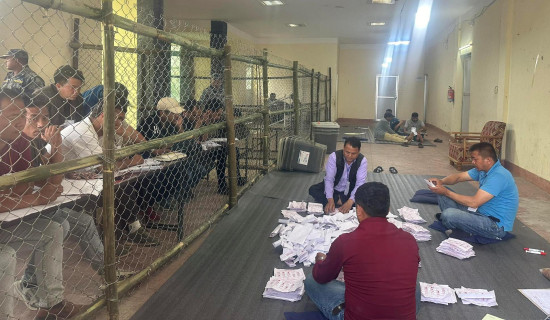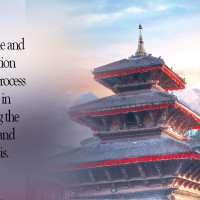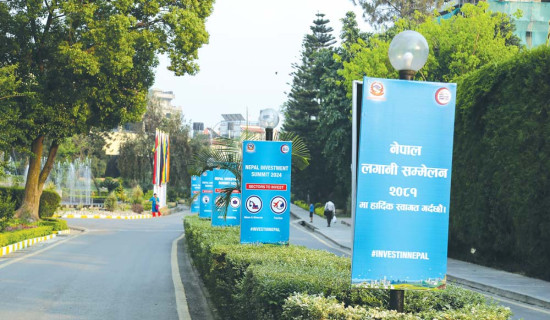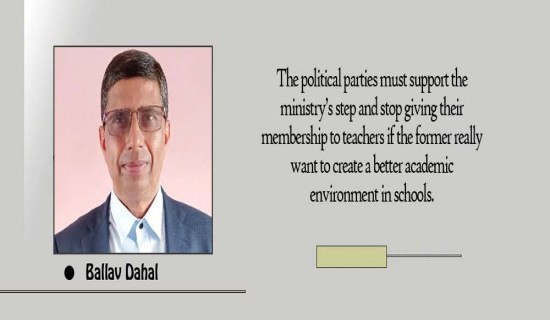- Tuesday, 30 April 2024
Opulent RATEPRI
Friends, Nepalis, and countrymen!
Lend me your ears!
I have come to tell you not that radio is the best, television a test and print media is rest. I do not want to showcase myself here as Shakespeare, who spoke through Mark Anthony during the burial of slain Julius Caesar (15 March 44 BC), but to explain my views on the glory of radio, television, plus the print media to all the honourable citizens of this country. Here ‘RATEPRI’ stands for radio, television, and print media.
I have also tried my level best to generate a cascade effect that could underscore the delicate equilibrium of the status of radio and television in Nepal. Honestly, I often become a “punch bag” when I sit down again for interviews in the glare of television cameras.
This article emanates in outlines regarding the interviews I face with various television stations on different occasions during which enthusiastic and inquisitive questions are asked as to which media organ is really winning the race today. Radio or television? Has radio now lost its glory in the wake of the television era? Repetitive questions! This article, based on the answers to the persistent questions, could beckon obvious replies with surgical precision. Please kindly allow me to present my opinion here!
At times, I feel it is institutional insanity to be grilled repeatedly with such questions, and my intrepid answers even put me on an unprecedented plateau of danger in dealing with those questions.
I have been a radio man since the “ice age” in Nepal, and as such, I solemnly embrace the electronic media with related answers by becoming as justifiable as I can. Hence, please allow me to turn myself into a “Packesel” first in order to carry loads of media baskets with answers to radio and television questions without allowing myself to exercise a misplaced vengeance between the two institutions.
Radio Nepal
To quench this thirst for media prosperity in Nepal, let us first of all go back to April 2, 1951, when “Radio Nepal” was first established in the country following the end of the Rana regime, which lasted a good 104 years in Nepal. Therefore, besides print media, “Radio Nepal" is without doubt the eldest blood brother of the Nepali electronic media clan. It was a pivotal era for the only radio station in the country that seamlessly transitioned into a sensation. Hence, the answer is loud and clear: the keys of “Radio Nepal” did unlock the past to salvation. This much, my radio experiences tell me!
Everyone involved in the establishment of “Radio Nepal” showed the unrelenting passion and dedication of the newfound electronic media success that gradually gained momentum in the country. The era of radio in Nepal and elsewhere cannot be put in a looming disastrous defeat in its broadcasting lifeline.
Its significance is still growing day by day. Radio transmission has been playing a profound and pivotal role among various sectors even today in terms of public security, policing, aviation, GPS navigation, terrorists, and crime hunts, just to name a few.
This justifies that radio is still the leader with proactive measures forging ahead with an even more professional approach to disseminating news and programmes with a high degree of “reachability” among listeners.
While saying this, my analysis does not intend to hurt the journalistic sentiments and spirits of another most cherished media organ—the television.
The broadcasting cult now opened ways to telecasting in Nepal, while at the same time construing its significance to satiate the Nepali TV viewers. Quenching thirst for visual news and through programmes gained momentum at an alarming rate with the establishment of the country’s only national television, blessed with the name “Nepal Television,” in 1985, with regular telecasting commencing only in 1986.
Much to wonder about the public on-screen chemistry, “Nepal Television” also led to the transcending of its viewers into real-life affection and excitement. People could now virtually watch most of their programmes on their beloved TV screens. TV viewers, with their newfound visual entertainment, gradually started to build some kind of distrust over radio broadcasting. Owning a TV set was a great source of pride and achievement in those early formative years.
Now, they gradually started having sight of their important entertainment programmes on TV rather than just being forced to listen to radio transmissions. Not to mention the other private television sectors that, of late, have sprung up gradually, like weeds, and whispers are swirling around that more aspiring TV stations are on the offing in Nepal. This justifies the question in German: “Wieviel Götter Braucht der Mensch?” (How many gods does a man need?)
If one opines that the modern media boom is television, social media, the Internet, etc., with radio now reportedly trailing far behind the visual wonders of today, then I am, as a radio man, bound to raise my eyebrows because putting radio and television on a two-edged sword with comparisons between the two entities of one winning over the prowess of the other could leave the telecasters and broadcasters scratching their heads in bewilderment.
Let us not forget that the two-edged sword, here radio and television, is cocooned in the same sheath. Hence, these two institutions, in my honest opinion, should unitedly keep tabloids buzzing for years to come instead of frowning upon each other. Only this can strike a balance between the two organisations without having to grope in darkness in order to find the “switch of communication” between them.
I do agree that this is an age of competition calling for drastic changes and facing challenges in media behaviour in Nepal. No matter how effective their working domain is, it is imperative and worthwhile to scrutinise how these two institutions work and how they differ from one another.
Here is a brief definition! “TV begins with a video camera. The camera records the pictures and sound of a TV programme. It changes the pictures and sound into electric signals. A TV set receives the signals and turns them back into pictures and sound.” (Courtesy: Google)
“Radio works by transmitting and receiving electromagnetic waves. The radio signal is an electronic current moving back and forth very quickly. A transmitter radiates this field outward via an antenna; a receiver then picks up the field and translates it to the sounds heard through the radio.” (Courtesy: Google)
So, you see, I am not a radio and television engineering genius. Someone has to pull me out safely from this complicated and confusing quagmire of mechanisms and technicalities. Thank you, Google! It is now clear how these two entities work in practical life. The difference is already there, e.g., pictures and sound (TV) and sound alone (radio). So, please do not tell me in mournful numbers that radio and TV are the same. One can adumbrate their seeming similarities, yet they go different ways in terms of functionality and approach.
In one of my TV interviews, I was pierced through with a question about the status of radio in the current age, when more and more people prefer to remain glued to their TV sets rather than lend their ears to radio programmes. Well! The choice must be determined and assessed, not in terms of the institutions. We must first of all ascertain what kind of target we are aiming at: viewers or listeners. The decision is yours.
Graded performance
When radio, television, and print media are contributing their own mite towards the progress and prosperity of the media culture in Nepal and elsewhere, there is certainly a graded performance in terms of solidarity and cooperation among these media institutions. In line with the enhancement of a progressive nature among these entities, the trend of cooperation does not need to be imported from anywhere to Nepal. Our own qualified media persons have been cooperating in one way or another by means of sharing their media expertise in flexible media institutions, e.g., radio presenters and editors working hand-in-hand with television and print entities and vice versa.
The same is the case with print media, which is literally associated with the production of radio and television programmes by way of feeding them with texts and prints. None of the electronic media apparatuses will work without the blessings of the print media. The prominent and elite editors of “Radio Nepal” also have worked in the television sector, like “Nepal Television, "showcasing professional teamwork. Likewise, editors of the print media, e.g., the oldest Nepali daily “Gorkhahapatra” and “The Rising Nepal," have excelled in their expertise in the electronic media too, by virtue of their age-old media-related profession. All these journalists engaged in their field of work have brought depth and dimension to their performances, no matter which media organ they are working with.
So, where is now the question that television or radio is better than the others, a question posed to me by many radio and TV journalists time and again, as I have stated above already? I am sure that I have answered these questions prudently and without prejudice of any kind.
The two-edged sword, however sharp and disastrous it can be, finally finds its abode inside its sheath. Interpreted literally, the two edges of the sword are the electronic media blades, here radio and television, and the sheath is its non-cryptic evidence of the print media cocooning and protecting radio and television by virtue of write-ups, etc., not forgetting the depth and dimensions of the print media that is also heavily engaged with the Internet, etc. Please do not forget that the world-spinning AI (artificial intelligence) that has made print media so easy to work with today is also there.

In order to strike my argument with resounding blows, I even asked some of the presenters during the interviews at both elite institutions to unplug the wires in their studios and conduct the programme. The result itself will be disastrous because, without wires, both entities will be dead, with radio becoming soundless and television running visuals without sound, both trudging in the deafening “sound of silence." Therefore, wires are an integral part of both radio, television, and print media. The wires serve as a bridge of communication between the institutions of all broadcasting and telecasting entities. We see here a “triangular effect” already, not a Bermuda Triangle, though.
Now, please tell me which broadcasting or telecasting entities will work without the wires. I just do not know whether this kind of argument can “hold water” or not, but I do know that the career trajectory cannot be the same for both radio and television. Arguments are solicited here! Thanks! Let us learn to admire both radio and television without being caught in the maze of confusion and without letting the question linger in the air like a persistent fog. “Per Curiam” on matters like these is a must. “Blowing one’s own trumpet” will not help much here.
Serving people
With my above-stated arguments, it becomes vividly clear that radio and television must cooperate together without creating much of a hullabaloo while journalistically serving the people. More explicit and advisable would be to admonish the fact that, in trying to understand, radio is the obverse and television is the reverse connotation of a coin. If this holds true, then we do not have “to put bees into our pockets and discuss the topic any further, and there will not be any withering blows being exchanged on one another, nor will there be quixotic efforts to lay spurious claims by degrading and insulting each other’s performances.
Be rest assured that these two institutions will always keep us enamoured of their raison d’être in Nepal and elsewhere by enthralling their listeners and viewers for many years to come. One thing is for sure: The breakthrough and subsequent rise in popularity of radio and television in Nepal was indeed not a mere stroke of luck; rather, they were the culmination of years of planning, patience, perseverance, and their unwavering commitment towards serving the public with their craft of visual and electromagnetic waves by weaving a tapestry of success in building trust and confidence among television viewers and radio listeners.
Strict statutory warnings are here! Let us all not delight ourselves in the ephemeral nature of success or good luck! If radio and television are entities of a career trajectory with added layers of visuals and sound, the print media is the overall bloodline and magnum opus of broadcasting and TV networks, newspapers, the internet, social media forums, etc. that we have today.
So, my encore and a standing ovation to the print media as well. Not to neglect here is also the fact that both radio and television owe their allegiance and gratitude towards this oldest form of media, print media, without doubt or any controversy.
I raise my glass in the name of the parental print media, including the “Gorkhapatra” and “The Rising Nepal” I grew up with in my formative years, not to forget other finger-countable weeklies, journals, and magazines of the day.
Not in my wildest dreams do I expect that these great media entities will ever go their separate ways, but if they did, otherwise the following could hold true and sound like "A Mexican pilot landing an American plane under instructions from an Indian controller using Dutch radio equipment!” Watch out! Please have the goodness of understanding this entire article as my panegyric for all the media forms and characteristics that helped me thrive and survive in Nepal. My adulation also goes to my countless honourable fans who inspired me to unfold my radio personality in Nepal! Similarly, my due respect goes to other private TV stations for taking me into their trust and showing their goodness by providing me with opportunities to speak through their television networks from time to time.
Allegiance
My allegiance also goes to the primaeval national daily “The Rising Nepal" for regularly providing me with the platform to share my media experiences with you all! Finally, it would be totally unwise of me if I kept another secret under wraps. It is about the landmark print media organ “Rastriya Samachar Samiti (RSS), which was established in 1960. It was RSS that, as an apex print media in Nepal, disseminated national and international news stories to most of the publications in Kathmandu and elsewhere in Nepal. I still recall the Nepali daily “Gorkhapatra” and “The Rising Nepal” having their own Telex machines too that would clatter for hours on end in the newsroom. Oh, those outgoing booms and incoming rumbles that the Telex machines would create then! One felt at times that he or she were in a “big news” factory with automatic assembly lines. It is no exaggeration at all to elucidate the fact that the RSS was always a “collaborative friend,” branching out to the perennial source of news information. I consider myself extremely fortunate to have grown up with the RSS in my formative years.
To sum up, the glory of radio, television, and print media (RATEPRI) have woven themselves into a fabric of success and joy during the period of my sometimes tumultuous editorial and broadcasting history, leaving an indelible mark in the psyche of my media injunction. Let us not succumb to the perils of fame and folly! May these media entities work on a cohesive decision to earn them an “Oscar” and etch their names indelibly in their onerous tasks and objectives!
Here is a reward to all of you for kindly reading this article! “If print media is a farmer, radio a milkman, and television a babysitter, the Internet is a drunken librarian who won’t shut up!” Long live print media! Long live radio! Long live television!
(The author is a retired senior English news editor and broadcaster at Radio Nepal.)





-square-thumb.jpg)











